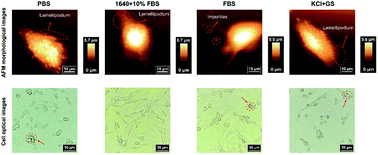The influence of different liquid environments on the atomic force microscopy detection of living bEnd.3 cells
Abstract
Atomic force microscopy (AFM) is one of the most important tools in the field of biomedical science, and it can be used to perform the high-resolution three-dimensional imaging of samples in liquid environments to obtain their physical properties (such as surface potentials and mechanical properties). The influence of the liquid environment on the image quality of the sample and the detection results cannot be ignored. In this work, quantitative imaging (QI) mode AFM imaging and mechanical detection were performed on mouse brain microvascular endothelial (bEnd.3) cells in different liquid environments. The gray-level variance product (SMD2) function was used to evaluate the imaging quality of the cells in liquids with different physical properties, and the variations in cell mechanical properties were quantitatively analyzed. An AFM detection liquid containing less ions and organics compared with the traditional culture medium, which is beneficial for improving the imaging quality, is introduced, and it shows similar mechanical detection results within 3 h. This can greatly reduce the detection costs and could have positive significance in the field of AFM living-cell detection.



 Please wait while we load your content...
Please wait while we load your content...